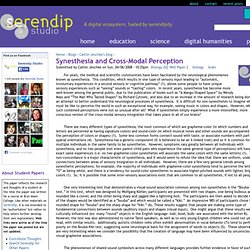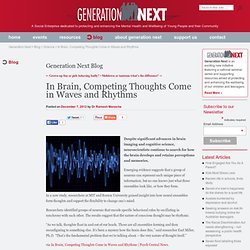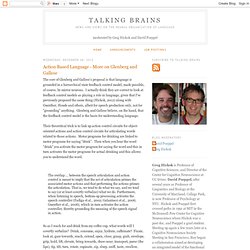

Synesthesia: A Union of the Senses - Second Edition (9780262032964): Richard E. Cytowic. Synesthesia and Cross-Modal Perception. For years, the medical and scientific communities have been fascinated by the neurological phenomenon known as synesthesia.

This condition, which results in one type of sensory input leading to “automatic, involuntary experiences in a second sensory or cognitive pathway” (1), allows some people to have unique sensory experiences such as “seeing” sounds or “tasting” colors. In recent years, synesthesia has become more well-known among the general public, due to the publication of books such as “A Mango-Shaped Space” by Wendy Mass and “The Man Who Tasted Shapes” by Richard Cytowic, and also due to an increase in the amount of research being done in an attempt to better understand the neurological processes of synesthesia. It is difficult for non-synesthetes to imagine what it must be like to perceive the world in such an exceptional way, for example, seeing music in colors and shapes.
However, what if such combined perceptions were not so unusual after all? Some researchers, such as D. A Critique of Embodied Simulation. Social cognition is the capacity to understand and interact with others.

The mainstream account of social cognition is mindreading, the view that we humans understanding others by interpreting their behavior in terms of mental states.... more Social cognition is the capacity to understand and interact with others. The mainstream account of social cognition is mindreading, the view that we humans understanding others by interpreting their behavior in terms of mental states. Recently theorists from philosophy, psychology, and neuroscience have challenged the mindreading account, arguing for a more deflationary account of social cognition. In this paper I examine a deflationary account of social cognition, embodied simulation, which is inspired by recent neuroscientific findings. Download (.doc) Share. Matlock,%20Teenie-%20B3.%20Metaphor%20as%20Embodied%20Simulation%20IN%20PRES. Gallese-Lakoff_2005.
15 Styles of Distorted Thinking. From Neurons to Neighborhoods: The Science of Early Childhood Development. Sensory substitution. Sensory substitution means to transform the characteristics of one sensory modality into stimuli of another sensory modality. It is hoped that sensory substitution systems can help handicapped people by restoring their ability to perceive a certain defective sensory modality by using sensory information from a functioning sensory modality.
A sensory substitution system consists of three parts: a sensor, a coupling system, and a stimulator. The sensor records stimuli and gives them to a coupling system which interprets these signals and transmits them to a stimulator. In case the sensor obtains signals of a kind not originally available to the bearer it is a case of sensory augmentation. Sensory substitution concerns human perception and the plasticity of the human brain; and therefore, allows us to study these aspects of neuroscience more through neuroimaging. History[edit] In Brain, Competing Thoughts Come in Waves and Rhythms. Generation Next Blog ← Grown-up fun or girls behaving badly?

• Meltdown or tantrum-what’s the difference? → Despite significant advances in brain imaging and cognitive science, neuroscientists continue to search for how the brain develops and retains perceptions and memories. Emerging evidence suggests that a group of neurons can represent each unique piece of information, but no one knows just what these ensembles look like, or how they form. In a new study, researchers at MIT and Boston University gained insight into how neural ensembles form thoughts and support the flexibility to change one’s mind. Researchers identified groups of neurons that encode specific behavioral rules by oscillating in synchrony with each other. “As we talk, thoughts float in and out of our heads. Via In Brain, Competing Thoughts Come in Waves and Rhythms | Psych Central News.
If you're new here, you can find out more about Generation Next events here. Talking Brains: November 2012. The core of Glenberg and Gallese's proposal is that language is grounded in a hierarchical state feedback control model, made possible, of course, by mirror neurons.

I actually think they are correct to look at feedback control models as playing a role in language, given that I've previously proposed the same thing (Hickok, 2012) along with Guenther, Houde and others, albeit for speech production only, not for "grounding" anything. Glenberg and Gallese believe, on the hand, that the feedback control model is the basis for understanding language. Their theoretical trick is to link up action control circuits for object-oriented actions and action control circuits for articulating words related to those actions. Motor programs for drinking are linked to motor programs for saying "drink".